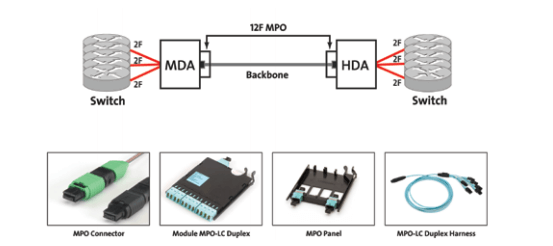With the continued requirement for expansion and scalability in the data center, cabling infrastructures must provide reliability, manageability and flexibility. Deployment of an optical connectivity solution allows for an infrastructure that meets these requirements for current and future data rates. A key factor when choosing the type of optical connectivity is scalability. Scalability refers to not only the physical expansion of the data center with respect to additional servers, switches or storage devices, but also to the scalability of the infrastructure to support a migration path for increasing data rates. As technology evolves and standards are completed to define data rates such as 40/ 100G Ethernet, Fibre Channel (32G and beyond) and InfiniBand (40G and beyond), the cabling infrastructures installed today must provide scalability to accommodate the need for more bandwidth in support of future applications.
Why the 12 Fibers MPO?
The MPO 12 fiber connector was the first MPO connector which had enough repeatable performance to be accepted in Data Centers. The 24, 48 and 72 were OK for FTTX but they were not good enough for high data, loss-sensitive applications. So with the MPO 12 fiber connector we started to see a real trend towards Data Center Backbone cabling that could be adapted over time. This is called ‘future-proofing’ or ‘migrating’. If you build a backbone with a 12 fiber MPO connector, you can basically put any connection on the end to be future proofed (LC, MTRJ, SC etc). This was really advantageous in the early day of Data Centers because nobody really knew what type of connector interface they needed on the switch/server. So basically the MPO 12 became the connector of choice in most backbone cabling infrastructures. The majority of Data Centers today are built with MPO 12 fiber in the backbone and MPO-LC harnesses connecting to equipment such as switches and servers. Most of the equipment today still has an LC transceiver interface therefore the harness is required to convert from MPO in the backbone to LC at the port. The 12 fiber MPO connector basically gives you 6 x serial LC duplex ports per connector. Each LC port has 1G or 10G of data rate capacity (Ethernet).
12 Fibers MPO Deploying in the Data Center for 40/100G
For optimized performance in meeting data center requirements, the topology of the cabling infrastructure should not be selected alone; infrastructure topology and product solutions must be considered in unison. Cabling deployed in the data center today must be selected to support data rate applications of the future, such as 100G Ethernet, Fibre Channel ≥ 32G and InfiniBand ≥ 40G. To do this, OM3 or OM4 fiber is a must. In addition to being the only multimode fibers included in the 40/100G Ethernet standard, OM3 and OM4 fibers provide the highest performance, as well as the extended reach often required for structured cabling installations in the data center.
In addition to the performance requirements discussed, the choice in physical connectivity is also important. Because parallel optics technology requires data transmission across multiple fibers simultaneously, a multifiber (or array) connector is required. Utilizing MPO-based connectivity in today’s installations provides the means to migrate to this multifiber parallel optic interface, when needed. Factory-terminated MPO solutions allow connectivity to be achieved through a simple plug & play system. To meet the needs of today’s serial Ethernet applications, MPOterminated backbone/horizontal cabling is simply installed into preterminated modules, panels or harnesses.

Cabling migration from 10G to 40G to 100G in an MPO-based system is a simple and easy deployment. Starting with 10G, a 12-fiber MPO cable is deployed between the two 10G switches. Modules are used at the end to transition from the 12-fiber MPO to LC duplex. This enables connectivity into the switch .

When the switches migrate to 40G, the module is removed and is replaced by a 12-fiber MPO adapter panel. The use of a 12-fiber MPO jumper is needed to establish connectivity between the switches.

Future 100G networks will require a 24-fiber MPO jumper to establish a link. Systems that use 12-fiber MPO backbone cabling will need a 24-fiber to two 12-fiber MPO jumpers.

Preparing for the Future
To best meet the needs of the future, MPO-based connectivity utilizing OM3 or OM4 fiber is the ideal solution in the data center. With inherent modularity and optimization for a flexible, TIA-942-compliant structured cabling installation, MPO-based optical fiber systems can be installed for use in today’s applications, while providing an easy migration path to future higher-speed technologies such as 40/100G Ethernet.
 EN
EN ES
ES DE
DE